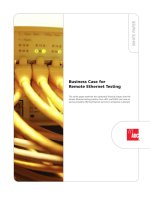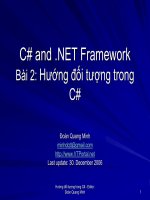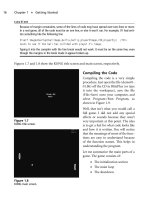Tài liệu C Programming for Embedded Systems docx
Bạn đang xem bản rút gọn của tài liệu. Xem và tải ngay bản đầy đủ của tài liệu tại đây (657.48 KB, 191 trang )
TEAMFLY
Team-Fly
®
Page i
C Programming for Embedded Systems
Kirk Zurell
Page ii
Disclaimer:
This netLibrary eBook does not include the ancillary media that was packaged with the original
printed version of the book.
R&D Books
CMP Media, Inc.
1601 W. 23rd Street, Suite 200
Lawrence, KS 66046
USA
Designations used by companies to distinguish their products are often claimed as trademarks. In all
instances where R&D is aware of a trademark claim, the product name appears in initial capital
letters, in all capital letters, or in accordance with the vendor's capitalization preference. Readers
should contact the appropriate companies for more complete information on trademarks and
trademark registrations. All trademarks and registered trademarks in this book are the property of
their respective holders.
Copyright © 2000 by Byte Craft Limited. Licensed Material. All rights reserved. Published by R&D
Books, CMP Media, Inc. All rights reserved. Printed in the United States of America. No part of this
publication may be reproduced or distributed in any form or by any means, or stored in a database or
retrieval system, without the prior written permission of the publisher; with the exception that the
program listings may be entered, stored, and executed in a computer system, but they may not be
reproduced for publication.
The programs in this book are presented for instructional value. The programs have been carefully
tested, but are not guaranteed for any particular purpose. The publisher does not offer any warranties
and does not guarantee the accuracy, adequacy, or completeness of any information herein and is not
responsible for any errors or omissions. The publisher assumes no liability for damages resulting
from the use of the information in this book or for any infringement of the intellectual property
rights of third parties that would result from the use of this information.
Cover art created by Robert Ward.
Distributed in the U.S. and Canada by:
Publishers Group West
1700 Fourth Street
Berkeley, CA 94710
ISBN 1-929629-04-4
Page iii
BYTE CRAFT LIMITED
421 King Street North
Waterloo, Ontario
Canada N2J 4E4
Telephone: (519) 888-6911
Fax: (519) 746-6751
E-mail:
All example and program code is protected by copyright.
Intel is a registered trademark of Intel Corporation.
Microsoft and Windows are trademarks or registered trademarks of Microsoft Corporation.
PC is a registered trademark of International Business Machines Corporation.
Motorola is a registered trademark of Motorola Inc.
COP8, MICROWIRE, and MICROWIRE/PLUS are trademarks or registered trademarks of
National Semiconductor Corporation.
PIC is a registered trademark of Microchip Technology Inc. in the USA
Scenix is a trademark of Scenix Semiconductor, Inc.
Cypress is a trademark of Cypress Semiconductor Corporation.
I2C is a registered trademark of Philips.
All other trademarks mentioned herein are property of their respective companies.
Page v
Acknowledgments
I would like to thank Walter Banks at Byte Craft Limited for dropping me head-first into the world
of embedded programming. Walter and Andre have provided copious expertise in the very finest
points of C programming and code generation.
I would also like to thank my parents, who went out on a limb and purchased that Commodore 64 all
those years ago. I hereby disclose publicly that I did not wash the dishes forever, as promised.
Page vii
Table of Contents
Acknowledgments v
Chapter 1
Introduction
1
Role of This Book 1
Benefits of C in Embedded Systems 2
Outline of the Book 3
Typographical Conventions 3
Updates and Supplementary Information 4
Chapter 2
Problem Specification
5
Product Requirements 5
Hardware Engineering 6
Software Planning 8
Software Architecture 9
Pseudocode 10
Flowchart 11
State Diagram 12
Resource Management 13
Testing Regime 14
Page viii
Chapter 3
Microcontrollers In-depth
17
The Central Processing Unit (CPU) 19
Instruction Sets 20
The Stack 20
Memory Addressing and Types 21
RAM and ROM 22
ROM and Programming 22
von Neumann Versus Harvard Architectures 23
Timers 24
Watchdog Timer 25
Examples 26 26
Interrupt Circuitry 26
Vectored and Nonvectored Arbitration 27
Saving State during Interrupts 29
Executing Interrupt Handlers 30
Multiple Interrupts 31
RESET 31
I/O Ports 32
Analog-to-Digital Conversion 33
Serial Peripheral Buses 34
Development Tools for a Microcontroller 36
Chapter 4
Design Process
37
Product Functionality 37
Hardware Design 38
Software Design 39
Software Architecture 39
Flowchart 40
Resource Management 42
Scratch Pad 42
Interrupt Planning 42
Testing Choices 44
Design for Debugging 44
Code Inspection 44
Execution within a Simulator Environment 45
Execution within an Emulator Environment 45
Target System in a Test Harness 45
Page ix
Chapter 5
C for Embedded Systems
47
In-line Assembly Language 47
Device Knowledge 49
#pragma has
49
#pragma port
51
Endianness 52
Mechanical Knowledge 52
Libraries 54
First Look at an Embedded C Program 54
Chapter 6
Data Types and Variables
57
Identifier Declaration 59
Special Data Types and Data Access 59
Function Data Types 60
The Character Data Type 60
Integer Data Types 61
Byte Craft's Sized Integers 61
Bit Data Types 61
Real Numbers 63
Complex Data Types 63
Pointers 63
Arrays 64
Enumerated Types 65
Structures 66
Unions 68
typedef
69
Data Type Modifiers 70
Value Constancy Modifiers: const and volatile 70
Allowable Values Modifiers: signed and unsigned 71
Size Modifiers:
short
and
long
72
Pointer Size Modifiers: near and far 72
Storage Class Modifiers 73
External Linkage 73
Internal Linkage 73
No Linkage 74
The extern Modifier 74
The static Modifier 75
The register Modifier 76
The auto Modifier 77
Page x
Chapter 7
C Statements, Structures, and Operations
79
Combining Statements in a Block 79
Functions 80
Function Parameters 81
Control Structures 81
The main() Function 81
Initialization Functions 82
Control Statements 82
Decision Structures 82
Looping Structures 84
Control Expression 84
break and continue 84
Operators and Expressions 86
Standard Math Operators 86
Bit Logical Operators 87
Bit Shift Operators 89
Chapter 8
Libraries
91
Creating Libraries 92
Writing the Library 95
Libraries and Linking 97
Chapter 9
Optimizing and Testing Embedded C Programs
99
TEAMFLY
Team-Fly
®
Optimization 100
Instruction Set-Dependent Optimizations 101
Hand Optimization 102
Manual Variable Tweaking 103
Debugging Embedded C 104
Register Type Modifier 104
Local Memory 104
Pointers 105
Mixed C and Assembly 105
Calling Conventions 105
Access to C Variables from Assembly 105
Exercising Hardware 106
Debugging by Inspection 106
Page xi
Dummy Loads 108
Working with Emulators and Simulators 108
Simulators 108
Emulators 109
The Packaging of Embedded Software 110
Chapter 10
Sample Project
111
Hardware Exercise Programs 111
"Hello World!" 112
Keypad Test 113
LCD Test 114
Talking to Ports 115
A/D Converter Theory 116
Appendix A
Table of Contents
119
Appendix A
Embedded C Libraries
123
Appendix B
ASCII Chart
163
Appendix C
Glossary
165
Index 171
What's on the CD-ROM? 180
Page 1
Chapter 1—
Introduction
1.1—
Role of This Book
This book provides a complete intermediate-level discussion of microcontroller programming using
the C programming language. It covers both the adaptations to C necessary for targeting an
embedded environment, and the common components of a successful development project.
C is the language of choice for programming larger microcontrollers (MCU), those based on 32-bit
cores. These parts are often derived from their general-purpose counterparts, and are both as
complex and feature-rich. As a result, C (and C++) compilers are necessary and readily available for
these MCUs.
In contrast, designers who have chosen to use 8-bit controllers have usually resorted to hand-coding
in assembly language. While manual assembly programming for precise control will never go out of
style, neither will the push to reduce costs. There are advantages in compiling high-level C language
to even the limited resources of an 8-bit MCU.
• Automatic generation of code for repetitive coding tasks, such as arithmetic for 16-bit or longer
data types.
Page 2
• Intuitive treatment of hardware peculiarities. Reading from or writing to a serial flash memory
device can be represented in C as a simple assignment statement, although the store operation
requires some coding.
• Platform-independence. The same cross-platformcapabilities that C brings to desktop computing
are available for the range of 8-bit microcontrollers on the market today.
This text shows you how to use C to program an 8-bit embedded MCU. We hope you are familiar
with C, but require in-depth information about microcontroller programming.
The main example project in this text is a computer-controlled thermostat. From an initial
specification, we progressively refine and augment the device in the same manner as any other
consumer or control product. With software development as our focus, we make choices and trade-
offs that any designer will need to make.
1.2—
Benefits of C in Embedded Systems
The direct benefits of using C in Embedded Systems design are as follows.
You will not be overwhelmed by details. 8-bit microcontrollers aren't just small: microcontrollers
include only the logic needed to perform their restricted tasks, at the expense of programmer
''comfort". Working with these limited resources through a C compiler helps to abstract the
architecture and keep from miring you down in opcode sequences and silicon bugs.
You will learn the basics of portability. Embedded applications are cost-sensitive. There may be
great incentive to change parts (or even architectures) to reduce the per-unit cost. However, the cost
of modifying assembly language code to allow a program written for one microcontroller to run on a
different microcontroller may remove any incentive to make the change.
You can reduce costs through traditional programming techniques. This book emphasizes C
code that generalizes microcontroller features. Details relating to specific hardware implementations
can be placed in separate library functions and header files. Using C library functions and header
files ensures that application source code can be recompiled for different microcontroller targets.
Page 3
You can spend more time on algorithm design and less time on implementation. C is a high
level language. You will be able to program your applications quickly and easily using C. C's
breadth of expression is concise and powerful; therefore, each line of code written in C can replace
many lines of assembly language. Debugging and maintaining code written in C is much easier than
in code written in assembly language.
1.3—
Outline of the Book
Determining the goals of software development is the first step, and is covered in Chapter 2. It
includes embedded-specific commentary about the regimen of predesign documentation crucial to
effective software development.
Chapter 3 provides an introduction to 8-bit microprocessors for those who have not dealt with them
on a low level before.
With a good plan and in-depth information about the central controller, the design process (covered
in Chapter 4) finalizes what was previously estimated. The processor-specific details about
implementing the thermostat are introduced.
Chapter 5 details hardware representation in C. It catalogs all the required set up for your program
source.
Chapter 6 provides insight into embedded data. The near and far variable storage modifiers mean
different things on an Intel PC running Microsoft Windows and on an embedded processor running
your code.
Chapter 7 completes the C portion, with embedded-specific information on functions, statements,
and operators.
Chapter 8 introduces libraries. Even in environments with a pittance of ROM and a very specific
task to do, libraries of prewritten functionality are a great help.
Chapter 9 provides insight into optimization, and helps you test your creation thoroughly.
Chapter 10 sums up with more information about the sample project. Though some information is
presented throughout the book, this chapter includes content not previously discussed.
1.4—
Typographical Conventions
Typography is used to convey contextual or implied information. The following examples provide a
guide to the conventions and their meanings.
Page 4
Table 1.1 Typographical usage
Bold identifies key terms.
Italic provides emphasis.
Letter
Gothic
denotes elements of programming language: identifiers, variable types, keywords, file
names, sample code and code excerpts.
Letter
Gothic
Italic
indicates replaceable elements in user input or in computer output.
0x is used to denote a hexadecimal number. For example: 0xFFF
0b is used to denote a binary number. For example: 0b010101
1.5—
Updates and Supplementary Information
If you are looking for more information on the thermostat project, please consult our supplementary
information via web:
/>
Page 5
Chapter 2—
Problem Specification
The problem specification is the initial documentation of the problem that your device and software
will solve. It should not include any specific design questions or product solutions. The main aim is
to explain in detail what the program will do.
Of course, there are as many ways to conduct project planning as there are workplaces on the planet.
Even the most standardized phases are observed in different fashions or in a different order. The
following sections are included because they add information about the embedded software realm,
or they pertain to the sample project specifically.
2.1—
Product Requirements
Often, this document is written from the users' point of view, as a series of user requirements. In the
case of an embedded system designed for a single task, you can be quite explicit and certain of the
extent of the product's intended functionality.
General decisions about hardware form part of the problem specification, especially in embedded
projects in which the hardware will be well controlled.
Page 6
Results
• Program will measure and display current temperature.
• Program will count real time on a 12- or 24-hour clock, and display hours and minutes on a digital
display.
• Program will accept time settings and set clock.
• Program will accept and store time settings for three daily usage periods.
• Program will switch between heating control and cooling control. Note that some HVAC experts
will see the need for occasionally operating both heating and cooling at the same time, but this
requirement more closely resembles traditional thermostat operation.
• Program will compare current temperature with settings for current time period, and turn on or turn
off external heating or cooling units as needed.
• Program will refrain from changing state of external units twice within a short period of time, to
permit the HVAC equipment to operate well.
• Program will accept manual override at any time, and immediately turn off heating or cooling unit.
2.2—
Hardware Engineering
This book does not deal directly with hardware, except for the example project. Nevertheless, the
target platform influences everything about the product. It determines the ease with which code is
generated by the compiler, and it determines some overall software design decisions.
If software developers are so lucky as to be involved in the hardware development process, the
opportunity to influence the design is too important to pass over. Wish-list items to ask for include
the following.
A Built-in Debug Interface Another method of field-programmability would also suffice. When a
device must be installed, customized, or repaired on site, a Flash-RAM part makes more sense than
an EEPROM or ROM device.
ROM Code Protection Embedded processors often provide protection against casual examination
of your ROM code. A configuration bit inhibits reading of ROM through the programming
interface. While there are sev-
Page 7
eral exploits against this protection, only a determined opponent will succeed in reading your
programming.
Rational Peripheral Interfaces The temptation to route circuits according to convenience can
overwhelm software performance quite quickly when it affects I/O organization. Does the desired
processor have bit-manipulation instructions to change port bits independently? Will multiplexed
interfaces require too much data direction switching?
Some peripherals can be replicated using generic I/O port lines and driver software. This saves
money but adds complexity to the programming challenge. Typically described as "bit-banging",
software must quickly and repeatedly write sequences of bits to port output lines, to imitate the logic
signals of a dedicated peripheral circuit.
Standard libraries, which might not contemplate a particularly-optimized hardware solution, can pay
for the added hardware cost in reduced software cost.
The central decision in hardware design is processor selection. The choice of a processor is a
negotiated decision, weighing factors such as the resources needed by the intended application, the
cost and availability of the part supply, and the development tools available. For an in-depth
treatment of microcontrollers, see the next chapter. Memory estimation does form part of our
problem specification, so estimation of RAM and ROM sizes is discussed in Section 2.3.5, Resource
Management.
Results
While we don't deal with hardware engineering in this book, we include some sample product
specification information for hardware to complete the information set.
Table 2.1 Initial hardware specifications
Engineering Factors Estimate
Operating Environment • domestic environment
• medium-power, medium-noise electrical connections
• occasional power loss
(table continued on next page)
Page 8
(table continued from previous page)
Engineering Factors Estimate
Interfaces • one multi-bit port for switching HVAC: probably only 3
pins necessary
• one multi-bit I/O interface for display
• one multi-bit I/O interface for keypad
• one A/D device for temperature sensing
• real time clock source: one second granularity
Memory Size (See the following text.)
Special Features • clock/counter or real time clock
• use of NVRAM depends upon whether and how the
processor might sleep
• watchdog timer might be helpful
Development Tools • C compiler
• simulator or emulator
• development board
2.3—
Software Planning
The software plan should say something about the choice of programming language. With
embedded systems, there are three general choices of development language: machine language, C,
or a higher-level language like BASIC. Of the three, C balances two competing needs.
• C approaches the performance of hand-coded machine language, compared to an interpreted
system like many BASICs. If a BASIC system ceases to be basic by exposing pointers or by
precompiling the source, the difficulty in testing begins to match that of C.
• C provides device-independence not offered by machine language. If you hand-code a program in
assembly, you run the risk of wasting it all with a change in microcontroller. Changing processors in
a design programmed in C can incur as little extra effort as changing a header file in your software
modules.
The first step in the software plan is to select an algorithm that solves the problem specified in your
problem specification. Various algorithms should be considered and compared in terms of code size,
speed, difficulty, and ease of maintenance.
TEAMFLY
Team-Fly
®
Page 9
Once a basic algorithm is chosen, the overall problem should be broken down into smaller problems.
The home thermostat project quite naturally breaks down into modules for each device:
• HVAC interface,
• keypad,
• LCD, and
• temperature sensor;
and then each function of that device.
Working from the block modules, you can write traditional pseudocode. This helps form the
identifiers and logical sections you will implement in your code.
The flowchart begins to make the transition from natural language pseudocode to actual code. In
the flowchart, we can begin to speculate about the data that functions will accept and provide. Most
importantly, we can begin to plan library usage. Even if there are no prewritten peripheral or data
conversion libraries available, we can write original code in library form and much more easily re-
use it later.
It is likely that different states have been introduced into the plan. A state diagram maps the
transitions, as a complement to the flowchart.
From the pseudocode, we can build a list of variables and make estimates about RAM and ROM
needs. The restriction of memory resources will come as a shock to some. Programmers working
with modern desktop environments are comfortable with huge memory spaces. Great fields of RAM
are available to create large data structures or arrays that may never actually be initialized or used.
In contrast, microcontrollers sport only as much RAM and ROM as is projected to be needed for a
specific class of target applications. Vendors strive to provide a range of similar parts, each variant
contributing only a small increase in on-chip resources.
Results
2.3.1—
Software Architecture
The language for programming the thermostat device will be C.
The main architectural dilemma involves the use of interrupts versus polling. Part of this dilemma
will be resolved in part selection: some processor variants do not include interrupts at all. Other
choices include explicit
Page 10
support for interrupt-driven keypads, or timers that generate interrupts upon timeout.
A serious facet of an interrupt-based solution is the protocol for communication between the
interrupts and main-line code. Since interrupts and main line are as independent as possible (an
interrupt may occur during any main-line instruction), race conditions are one consequence.
We have chosen the simplest of several alternative algorithms: a clock/counter interrupt will
calculate time, request a display update and set target temperatures. The main line will loop to poll
the keyboard, to sample environment temperature, to update the display, and to switch the HVAC
machinery. This requires only a precise timing interrupt, which is essential for 24-hour timekeeping.
2.3.2—
Pseudocode
Pseudocode presents in natural language the imperative steps of the program. It is especially useful
in embedded programming because every aspect of execution can be planned together: there is no
need to account for operating system oddities.
In the following example, we assume that time is kept with a counter and
software.
1. Initialization
(a) Set clock counter to 0.
(b) Set time and temperature target variables to defaults.
(c) Enable time interrupt.
2. Clock/counter triggers an interrupt each second
(a) Increment clock counter.
(b) Request display update.
(c) Loop through the preset cycles. If clock is at or past the indexed cycle time, set target
temperature to that cycle.
3. Main loop
(a) Sample environment temperature.
(1) If environment temperature is outside target temperature, turn on heat or cool.
(2) If environment temperature is inside target temperature, turn off heat or cool.
(b) Write time, environment temperature, and status to LCD.
Page 11
(c) Wait for keystroke
(1) If key is pressed, wait for debounce period and check again.
(d) Parse keystroke
(1) If shutdown command is sent, shut down operating units immediately.
(2) If cycle selection command is sent, change to next cycle record.
(3) If time setting is sent, adjust time in current cycle record.
(4) If temperature setting is sent, adjust temperature in current cycle.
2.3.3—
Flowchart
This diagram is basically a representation of the relationships between major and minor tasks in the
embedded software. The flowchart helps determine
• what functionality goes in which logical module and
• what functionality you expect (or hope) to be supplied by libraries.
You can also begin to give identifiers to important constructs.
Page 12
Figure 2.1
Data flow for the algorithm
2.3.4—
State Diagram
The software will likely express different states, moving between them after processing external
interaction or internal events. This diagram illustrates these states and the stimuli that make it
progress through them.









